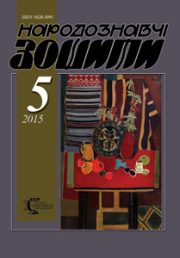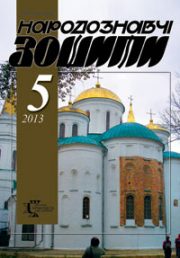The Ethnology Notebooks. 2021. № 4 (160), 918—928
UDK[75.011.26:2-2:398](=161.2)”17/19″
DOI https://doi.org/10.15407/nz2021.04.918
FOLK PAINTING OF THE 18—20th CENTURIES: FROM SACREDNESS TO FOLKLORE
Triska Oksana
- ORCID ID: https://orcid.org/0000-0002-4717-4396
- Candidate of Art Studies, Senior Researcher,
- Ethnology Institute of National Academy of Sciences of Ukraine,
- Folk Art Department,
- 15, Svoboda Avenue, 79000, Lviv, Ukraine,
- Contacts: e-mail: oksana_triska@yahoo.de
SHPAK Oksana
- ORCID ID: https://orcid.org/0000-0002-9719-4432
- Candidate of Art Studies, Senior Researcher,
- Ethnology Institute of National Academy of Sciences of Ukraine,
- Folk Art Department
- 15, Svoboda Avenue, 79000, Lviv, Ukraine,
- Contacts: e-mail: shpak.oksana@gmail.com
Abstract. Introduction, Problem Statement. The article examines the works of folk painting (domestic icons and folk paintings) in the rural life of Ukrainians in terms of sacredness and folklore as symbolic categories for each of the subspecies. The novelty of the subject lies in the complex analysis of works of religious and secular nature, which existed in the same ethnic environment, but experienced a rise and decline in different time perspectives. The Purposeof the article is to trace the evolution of the subject of folk painting, to investigate the dynamics of its development during the XVIII—XX centuries. Methods. With the help of the historical and cultural method, it is important to follow the change in the subject of the works. It is also important to follow the filling of the works with folklore elements using the artistic-stylistic method. The prospect of further research is to deepen the theoretical study of the categories of sacredness and folklore in art history; to form a holistic panorama of the development of home folk painting, supplemented by other painting practices.
Results. Home icons that were Christian symbols of the Ukrainian peasantry from the second half of the 18th century until the beginning of the 20th century, created a holistic artistic phenomenon, built on the repetition of traditional plots and figurative language. Prolonged constancy of themes and embodied ideologically aesthetic and artistic concepts contributed to the canonicity of the phenomenon. Its key criteria were sacredness and folklore. In the domestic icon, the folk understanding of sacredness was manifested in a simplified and symbolic disclosure of iconographic themes, and understanding of folklore — in ornamental accompaniment, the representation of folk types and conciseness (brightness) of color. Folklore of the Ukrainian folk painting of the 18—20th centuries manifested itself at the level of thematic connection with song folklore, as well as in formally plastic means (decorativeness, bright coloring, reproduction of folk types). Sacredness in the folk picture is associated with canonicity (stable repetition of iconographic and compositional schemes), «sacralization» of individual plots, which in the period of anti-religious prohibitions in the twentieth century replaced domestic icons and became symbols of spirituality.
Keywords: domestic icon, folk painting, traditional painting, works of religious and secular character.
Received 1.07.2021
REFERENCES
- Sheliuto, V.M. (2010). The problem of sacred as a worldview problem.: Nauka. Relihiia. Suspil’stvo, 4, 96 [in Ukrainian].
- Kuzmenko, O., & Chornopyskyi, M. (Ed.). (2008). Folklore. Ukrainian folklore. Dictionary-reference. (P. 414).Ternopil’: Pidruchnyky i posibnyky [in Ukrainian].
- Zholtovs’kyj, P.M. (1978). Ukrainian painting XVII-XVIII cent. (P. 277). Kyiv: Naukova dumka [in Ukrainian].
- Svientsitska, V.I., & Otkovych, V.P. (Eds.). (1991).Ukrainian folk painting of XII-XX xx centuries: The world through the eyes of folk artists: Album, Kyiv: Mystetstvo [in Ukrainian].
- Najden, O. (2009). People’s icon of the Middle Dnieper in the context of peasant cultural space. Kyiv: Institute of Art Studies, Folklore Studies and Ethnology named after M.T. Rylsky NAS of Ukraine [in Ukrainian].
- Najden, O. (2005). Image of a warrior in Ukrainian folklore: Semantic and figurative aspects.(Pp. 7, 16). Kyiv: Stylos [in Ukrainian].
- Najden, O.S. (1997). Ukrainian folk painting. Folklore and ethnohistorical aspects of the origin and functions of images. Dis…. doctoral of the city. 17.00.01. Kyiv [in Ukrainian].
- Romaniv-Triska, O., Kis’, A., & Molodyj, O. (Eds.). (2015). People’s icon of Chernihiv. Compilers: O. Romanov-Triska, A. Kis, O.Molody: Album, L’viv: Institute of Collectibles of Ukrainian Art Monuments at NTSH, [in Ukrainian].
- Kryms’kyj, A.Yu. (2009). Zvenigorod region. Shevchenko’s homeland from the point of view of ethnographic and dialectological: Reproduction from the author’s layout 1930 r. (Pp. 183—184). Cherkasy: Vertykal’ [in Ukrainian].
- Stankevych, M. (2020). Ethnoesthetics. Philosophy of folk art. Ivano-Frankivsk (P. 56). Ivano-Frankivsk; Kyiv; L’viv: SKIM [in Ukrainian].
- Poshyvajlo, T. (Marchenko), Skrypnyk, H., & Kara-Vasyl’ieva, T. (Eds.). (2007). Folk painting «Kozak-Mamay». History of decorative art of Ukraine: in 5 t. Art of XVII—XVIII centuries (Vol. 2, p. 267). Kyiv: IMFE im. M.T. Ryl’s’koho NAN Ukrainy [in Ukrainian].
- Stasenko, V. (2003). Christ and the Virgin Mary in the tree cuts of Cyrillic books of Galicia XVII century: features of the development and interpretation of the image.(P. 121). Kyiv [in Ukrainian].
- Romaniv-Triska, O. (Ed.). (2008). People’s icon on glass. Album.(Pp. 172, 173, 187). L’viv: Instytut kolektsionerstva ukrains’kykh mystets’kykh pam’iatok pry NTSh [in Ukrainian].






